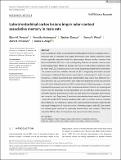Files in this item
Lateral entorhinal cortex lesions impair odor-context associative memory in male rats
Item metadata
| dc.contributor.author | Persson, Bjorn M. | |
| dc.contributor.author | Ambrozova, Veronika | |
| dc.contributor.author | Duncan, Stephen | |
| dc.contributor.author | Wood, Emma | |
| dc.contributor.author | O'Connor, Akira Robert | |
| dc.contributor.author | Ainge, James | |
| dc.date.accessioned | 2022-02-21T10:30:02Z | |
| dc.date.available | 2022-02-21T10:30:02Z | |
| dc.date.issued | 2022-03-22 | |
| dc.identifier | 277496109 | |
| dc.identifier | 9564aefb-26ad-4bfd-a71d-31fe9db34349 | |
| dc.identifier | 85124908128 | |
| dc.identifier | 000762351400001 | |
| dc.identifier.citation | Persson , B M , Ambrozova , V , Duncan , S , Wood , E , O'Connor , A R & Ainge , J 2022 , ' Lateral entorhinal cortex lesions impair odor-context associative memory in male rats ' , Journal of Neuroscience Research , vol. 100 , no. 4 , pp. 1030-1046 . https://doi.org/10.1002/jnr.25027 | en |
| dc.identifier.issn | 0360-4012 | |
| dc.identifier.other | ORCID: /0000-0002-0007-1533/work/108913792 | |
| dc.identifier.other | ORCID: /0000-0002-7943-5183/work/108915111 | |
| dc.identifier.uri | https://hdl.handle.net/10023/24912 | |
| dc.description | This work was supported by the Biotechnology and Biological Sciences Research Council (BBSRC) [grant number BB/M010996/1]. | en |
| dc.description.abstract | Lateral entorhinal cortex (LEC) has been hypothesized to process nonspatial, item information that is combined with spatial information from medial entorhinal cortex to form episodic memories within the hippocampus. Recent studies, however, have demonstrated that LEC has a role in integrating features of episodic memory prior to the hippocampus. While the precise role of LEC is still unclear, anatomical studies show that LEC is ideally placed to be a hub integrating multisensory information. The current study tests whether the role of LEC in integrating information extends to long-term multimodal item-context associations. In Experiment 1, male rats were trained on a context-dependent odor discrimination task, where two different contexts served as the cue to the correct odor. Rats were pretrained on the task and then received either bilateral excitotoxic LEC or sham lesions. Following surgery, rats were tested on the previously learned odor-context associations. Control rats showed good memory for the previously learned association but rats with LEC lesions showed significantly impaired performance relative to both their own presurgery performance and to control rats. Experiment 2 went on to test whether impairments in Experiment 1 were the result of LEC lesions impairing either odor or context memory retention alone. Male rats were trained on simple odor and context discrimination tasks that did not require integration of features to solve. Following surgery, both LEC and control rats showed good memory for previously learned odors and contexts. These data show that LEC is critical for long-term odor-context associative memory. | |
| dc.format.extent | 17 | |
| dc.format.extent | 1019234 | |
| dc.language.iso | eng | |
| dc.relation.ispartof | Journal of Neuroscience Research | en |
| dc.subject | Episodic Memory | en |
| dc.subject | Odour memory | en |
| dc.subject | Context | en |
| dc.subject | Hippocampus | en |
| dc.subject | Recognition memory | en |
| dc.subject | RRID:AB_2298772 | en |
| dc.subject | RRID:SCR_013672 | en |
| dc.subject | RRID:SCR_018321 | en |
| dc.subject | RRID:SCR_019096 | en |
| dc.subject | RC0321 Neuroscience. Biological psychiatry. Neuropsychiatry | en |
| dc.subject | DAS | en |
| dc.subject.lcc | RC0321 | en |
| dc.title | Lateral entorhinal cortex lesions impair odor-context associative memory in male rats | en |
| dc.type | Journal article | en |
| dc.contributor.institution | University of St Andrews. School of Psychology and Neuroscience | en |
| dc.contributor.institution | University of St Andrews. Institute of Behavioural and Neural Sciences | en |
| dc.identifier.doi | 10.1002/jnr.25027 | |
| dc.description.status | Peer reviewed | en |
This item appears in the following Collection(s)
Items in the St Andrews Research Repository are protected by copyright, with all rights reserved, unless otherwise indicated.

